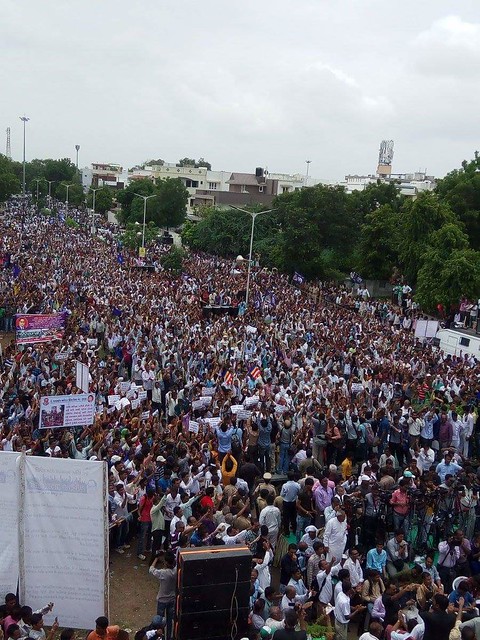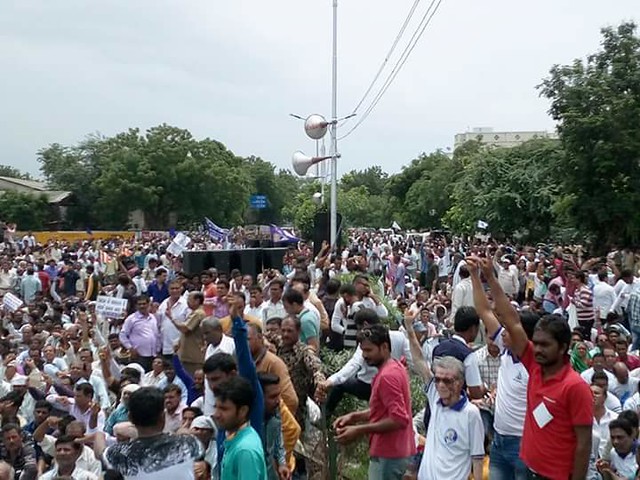By Amit Kumar, TwoCircles.net
The Gau Raksha Dals can stand and take notice now.
For the past few years, these vigilantes, in the name of cow protection, have terrorised Muslims and Dalits, knowing well that they have the support and the blessings of the Sangh Parivar. In his death, Mohammed Akhlaq became another casualty to the politics of cow-protection. However, Muhammad Majloom (35) and Azad Khan alias Ibrahim (15) may not even make it to the pages that chronicle the acts of these Dals, which have attacked and killed people in Rajasthan, UP, Madhya Pradesh and Maharashtra.

The two traders from Jharkhand were lynched by cow protection groups. According to police, preliminary investigation revealed that the two were on their way to a cattle market in Chatra district to sell eight oxen with them. The two were tortured, and one of them was a teenager.
But does it surprise anyone? Or more worryingly, do these acts invoke any anger among the communities at the receiving end of such acts?
If the protests on Sunday in Ahmedabad are anything to go by, then yes. The anger is now visible. When 50,000 people took to the streets to protest against the Una violence case, even mainstream media stood up and took notice. On July 11, when cow protection vigilantes thrashed four Dalits for skinning dead cows, the message from them was clear: we will do as we please, and no one can stop us. Or so they thought. But little did they know that the video of four Dalits being thrashed in the open, and in front of police (which was recorded by a member of the Gau Raksha Dal) would infuriate so many people. Within a day, the video had gone viral on social network and the anger among the Dalit community was both visible and justified.
However, what was even more surprising was that unlike in the past, the news did not die the next day and turned into a massive headache for the Anandiben-led BJP government in Gujarat. According to Mohammed Kaleem Siddiqui, editor of Tarkash, an Ahmedabad-based Urdu paper, the incident in Una angered the Dalits because of the audacity of the culprits. “This was no sneak attack; it was done in full public view with the police acting as mute spectators, or worse, as silent associates to these thugs. The Dalit community was hurt because this was neither new, nor the last time that they had been attacked,” he told Twocircles.net. According to him, however, the main reason that the protests have been so huge, is because the local activists ensured that this incident was not hijacked by political parties who wanted to corner BJP. Siddiqui, who was present at the protests on Sunday, said that when a few Congress leaders tried to speak at the protests, they were booed off the stage immediately. “The Dalits made it clear: you cannot continue to speak for us, and toe your party line at the same time,” he said.

According to activists, the protests following the Una incident are also like to provide momentum to other Dalit struggles in the state. One such case is the police shooting in Thangadh, where three Dalits lost their lives at the hands of the police. For the past three years, the families of the victims have been running pillar to post for justice but to no avail. Shamshad Pathan, a lawyer based out of Gujarat and has been working closely with the family, believes that ever since the Una incident, there is hope that these protests will also gain the attention of the media and the government. “Today, we sat for a Dharna in Gandhinagar to demand justice for the victims, and there were more than 200 people who joined us. This is a relay protest and we expect more people to join us,” he told Twocircles.net. He added that although the two events (Una violence and Thangadh incident) are not directly connected, the people who have been at the forefront of Una protests, like Jignesh Mevani, have been working with the Thangadh victims too from the beginning.
Dalit-Muslim unity at a nascent stage in Gujarat, but the signs are encouraging
One of the more encouraging signs from the recent protests in Gujarat have been the support extended by Muslim organisations to Dalits. Although Muslims and Dalits have shared the same space in urban centres in cities of Gujarat, until now, according to Siddiqui, there has been little trust between the two communities, especially since the RSS and its sister organisations have made substantial inroads into Dalit spaces. “Over the past decade or so, there has been a substantial effort on the part of right-wing forces to impose their ideology on the Dalits at the cost of Ambedkarite ideas. Furthermore, Muslims remain sceptical of Dalits due to their role in 2002 riots,” says Siddiqui.
However, on Sunday, a small but important intervention was made by members of the two communities in joining hands to protests against the Gau Rakshak Dals. “Both communities have been at the receiving end of such actions, and hence it is natural for them to come together,’ he added. He also pointed out that it was not as if Muslims participated in large numbers. “Although there were representatives from Jamat-e-Ulama-e-Hind, Jamat-e-Islami and Insaf Foundation, most Muslims who joined the protests came off their own accord. More than the members of these organisations, it was the presence of Mufti Abdul Qayyoom Mansoori and his supporters which was welcomed by the protesters. Mufti Abdul Qayyum, who was acquitted by the Supreme Court in the 2002 Akshardham temple terror attack in 2014, joined the rally in solidarity with Dalits. He was given a warm welcome by Dalits and raised slogans like “Dalit muslim bhai bhai; jai bheem jai meem; Dalit Muslim saath chalega manuvadi bhaag niklega and Dalit muslim ekta zindabad”.
With news emerging that Gujarat Chief Minister Anandiben Patel had resigned from her office, it is clear that the state government has been left shaken by the wave of protests. How much this does to curb the root of the problem–Gau Raksha Dals–remains to be seen.

